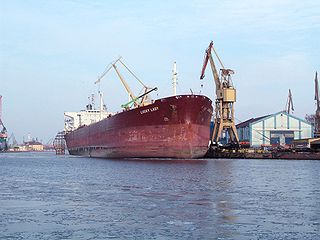Negligence is a failure to exercise appropriate and/or ethical ruled care expected to be exercised amongst specified circumstances. The area of tort law known as negligence involves harm caused by failing to act as a form of carelessness possibly with extenuating circumstances. The core concept of negligence is that people should exercise reasonable care in their actions, by taking account of the potential harm that they might foreseeably cause to other people or property.
In law and insurance, a proximate cause is an event sufficiently related to an injury that the courts deem the event to be the cause of that injury. There are two types of causation in the law: cause-in-fact, and proximate cause. Cause-in-fact is determined by the "but for" test: But for the action, the result would not have happened. The action is a necessary condition, but may not be a sufficient condition, for the resulting injury. A few circumstances exist where the but for test is ineffective. Since but-for causation is very easy to show, a second test is used to determine if an action is close enough to a harm in a "chain of events" to be legally valid. This test is called proximate cause. Proximate cause is a key principle of Insurance and is concerned with how the loss or damage actually occurred. There are several competing theories of proximate cause. For an act to be deemed to cause a harm, both tests must be met; proximate cause is a legal limitation on cause-in-fact.

Hedley Byrne & Co Ltd v Heller & Partners Ltd [1964] AC 465 is an English tort law case on economic loss in English tort law resulting from a negligent misstatement. Prior to the decision, the notion that a party may owe another a duty of care for statements made in reliance had been rejected, with the only remedy for such losses being in contract law. The House of Lords overruled the previous position, in recognising liability for pure economic loss not arising from a contractual relationship, applying to commercial negligence the principle of "assumption of responsibility".

English tort law concerns the compensation for harm to people's rights to health and safety, a clean environment, property, their economic interests, or their reputations. A "tort" is a wrong in civil, rather than criminal law, that usually requires a payment of money to make up for damage that is caused. Alongside contracts and unjust enrichment, tort law is usually seen as forming one of the three main pillars of the law of obligations.

An exclusion clause is a term in a contract that seeks to restrict the rights of the parties to the contract.
In the English law of tort, professional negligence is a subset of the general rules on negligence to cover the situation in which the defendant has represented him or herself as having more than average skills and abilities. The usual rules rely on establishing that a duty of care is owed by the defendant to the claimant, and that the defendant is in breach of that duty. The standard test of breach is whether the defendant has matched the abilities of a reasonable person. But, by virtue of the services they offer and supply, professional people hold themselves out as having more than average abilities. This specialised set of rules determines the standards against which to measure the legal quality of the services actually delivered by those who claim to be among the best in their fields of expertise.
In the English law of negligence, the acts of the claimant may give the defendant a defence to liability, whether in whole or part, if those acts unreasonably add to the loss.
A Himalaya clause is a contractual provision expressed to be for the benefit of a third party who is not a party to the contract. Although theoretically applicable to any form of contract, most of the jurisprudence relating to Himalaya clauses relate to maritime matters, and exclusion clauses in bills of lading for the benefit of employees, crew, and agents, stevedores in particular.

Overseas Tankship (UK) Ltd v Morts Dock and Engineering Co Ltd, commonly known as Wagon Mound , is a landmark tort law case, which imposed a remoteness rule for causation in negligence. The Privy Council held that a party can be held liable only for loss that was reasonably foreseeable. Contributory negligence on the part of the dock owners was also relevant in the decision, and was essential to the outcome, although not central to this case's legal significance.

London Drugs Ltd v Kuehne & Nagel International Ltd, [1992] 3 SCR 299 is a leading decision of the Supreme Court of Canada on privity of contract.

George Mitchell (Chesterhall) Ltd v Finney Lock Seeds Ltd [1982] EWCA Civ 5 and [1983] 2 AC 803 is a case concerning the sale of goods and exclusion clauses. It was decided under the Unfair Contract Terms Act 1977 and the Sale of Goods Act 1979.

Spartan Steel & Alloys Ltd v Martin & Co (Contractors) Ltd [1973] QB 27 is a well-known English Court of Appeal case concerning the recovery of pure economic loss in negligence.

Hollier v Rambler Motors (AMC) Ltd[1971] EWCA Civ 12 is an English contract law case, concerning the incorporation of terms into a contract and the contra proferentum rule of interpretation. It shows an example of a very hostile interpretation of exclusion clauses.
South Australia Asset Management Corporation v York Montague Ltd and Banque Bruxelles Lambert SA v Eagle Star Insurance Co Ltd [1996] UKHL 10 is a joined English contract law case on causation and remoteness of damage. It arose out of the property crash in the early 1990s, whereby banks were suing valuers for overpricing houses in order to recover the lost market value. Owners themselves often had little or no money, since they had fallen victim to negative equity, so mortgage lenders would pursue a valuer instead to recover some losses. The legal principle arising from the case is often referred to as the "SAAMCO principle".
Interpreting contracts in English law is an area of English contract law, which concerns how the courts decide what an agreement means. It is settled law that the process is based on the objective view of a reasonable person, given the context in which the contracting parties made their agreement. This approach marks a break with previous a more rigid modes of interpretation before the 1970s, where courts paid closer attention to the formal expression of the parties' intentions and took more of a literal view of what they had said.

Williams v Natural Life Health Foods Ltd[1998] UKHL 17 is an important English tort law, company law and contract law case. It held that for there to be an effective assumption of responsibility, there must be some direct or indirect conveyance that a director had done so, and that a claimant had relied on the information. Otherwise only a company itself, as a separate legal person, would be liable for negligent information.

Canada Steamship Lines Ltd v R[1952] UKPC 1 is a Canadian contract law case, also relevant for English contract law, concerning the interpretation of unfair terms contra proferentem. The case was decided by the Judicial Committee of the Privy Council on appeal from the Supreme Court of Canada, as the cause for appeal arose before the abolition of such appeals in 1949. Although arising in civil law under the Civil Code of Lower Canada, it has been influential in similar cases under English law.

Dutton v Bognor Regis Urban District Council [1972] 1 QB 373 is an English contract law and English tort law case concerning defective premises and the limits of contract damages. It was disapproved by the House of Lords in Murphy v Brentwood DC and is now bad law except in Canada and New Zealand.
First National Bank of SA Ltd v Rosenblum and Another is an important case in South African contract law, heard in the Supreme Court of Appeal (SCA) by Marais JA, Navsa JA and Chetty AJA on May 21, 2001, with judgment handed down on June 1. Counsel for the appellant was MD Kuper SC ; PM Wulfsohn SC appeared for the respondents.
The civil liability of a recreational diver may include a duty of care to another diver during a dive. Breach of this duty that is a proximate cause of injury or loss to the other diver may lead to civil litigation for damages in compensation for the injury or loss suffered.











